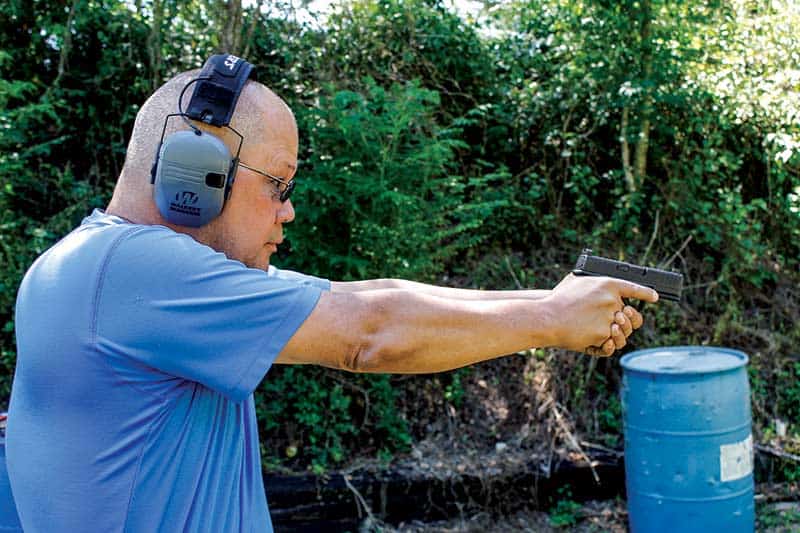Take a timer to the range and see for yourself, says Mas.
You don’t necessarily have to draw to be in a ready position. Police work being a dangerous profession, cops often have to draw their guns proactively. Some “police reform” advocates are demanding cops write a report every time their pistol clears the holster.
The NC Charlotte Observer reported in 2020, “Charlotte Mecklenburg Police will start tracking every time an officer draws a weapon and points it at someone. The additional reporting is enabled by a new sensor — sometimes called a holster monitor — which automatically turns on an officer’s body-worn camera when a firearm is removed from its holster…. CMPD Chief Johnny Jennings said all officers have now been outfitted with the new ‘signal sidearm’ sensor.
Officers will also be required to report why they drew the weapon and what they did with the weapon after it was drawn — including whether it was pointed at anyone, he said.”
That is over the top. Here are some thoughts on reducing the number of draws and avoiding the onerous process.
Drawn Gun Disadvantages
First, recognize there are many times when a two-hand hold of a drawn duty pistol gets in the way of other things an endangered cop, or, for that matter, an armed citizen, might need to be doing with their hands.
You may have to be manipulating a communications device or illumination device. In the dark, on unfamiliar floors or broken or slippery ground, there is always the possibility of a fall: The result can be a handgun knocked out of battery, its muzzle plugged with snow or mud, or a lost gun. If a situation goes rapidly to “hands-on-suspect,” getting the gun put away quickly becomes an issue. If jumped in the dark, that drawn gun may be the target of a snatch attempt.
“Hand on Gun” Technique
As a young patrolman in the ’70s, I got into the habit of mostly keeping my hand on a holstered weapon with the retaining device released. Jim Lindell taught me handgun retention in Kansas City and I knew “hand on holstered weapon” was the single strongest position for the “Good Guy” when a struggle began.
If you let go of the pistol, today’s uniform duty holsters, such as the Bill Rogers-designed Safariland, will activate the retaining device as soon as your hand leaves the holster. If ready to draw, your thumb will have already deactivated the release mechanism. You only have to worry about the effect on speed and accuracy if you need to shoot.
Speed And Accuracy
How much speed are you losing with the “hand on a holstered gun” instead of already drawn?
I took a timer to the range with my S&W 1911 .45. Starting cocked and locked at low ready from 10 feet, my time to react and fire averaged 0.64 seconds with all center hits. Starting with the hand on the holstered pistol, the average time was 0.916 seconds to react, draw and fire from a two-handed stance. Going for speed, I dropped a few points: 84% hit value as opposed to the 100% from low ready. The time difference had been only a little more than a quarter of a second — 0.276 seconds.
I went to the range with three good friends and repeated the test using Springfield Armory Hellcat Pro striker-fired guns with iron sights from an open-top Kydex. Smarter than me, they went for accuracy instead of speed, and all got 100% hit value from both low ready and starting with “hand on a holstered weapon.”
IDPA Five-Gun Master John Strayer averaged 0.686 seconds from low ready and 1.068 seconds from hand on a holstered gun, an average difference of 0.382 of one second. Retired state investigator Allen Davis averaged 0.564 from low ready and 1.024 from hand on a holstered gun, a difference of 0.46 of one second. The average overall was 0.67 from low ready and 1.178 from hand on a holstered gun — a difference of 0.508 of a second.
If you have an immediate identified threat, you want the gun up and out to start, but for less critical situations, a quarter to a half a second isn’t much of a price to pay for the advantages of “hand on the holstered pistol.”
And in Charlotte-Mecklenberg, you won’t have to write a report, which the cop-haters will use to say you’re gun-happy. Slowing down for the “speed’s fine, accuracy’s final” advice that has stood the test of time from Wyatt Earp to Bill Jordan doesn’t cost you that much.
Try it yourself: What works for you is what’s important. Keep your mind open and your hand full. Having a hand on a holstered gun is the optimum “ready” for some situations.


